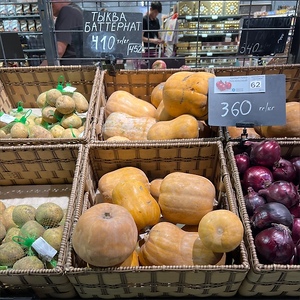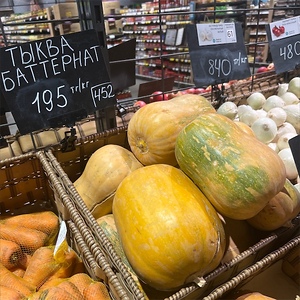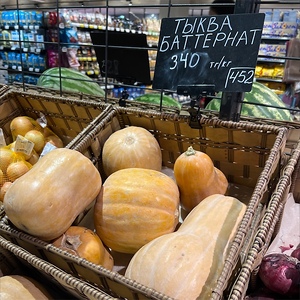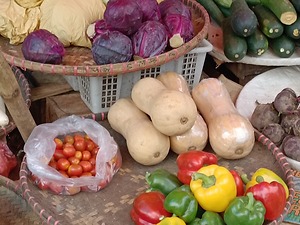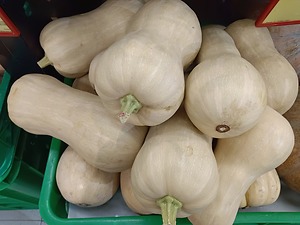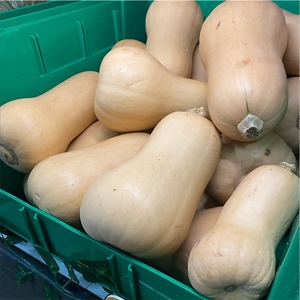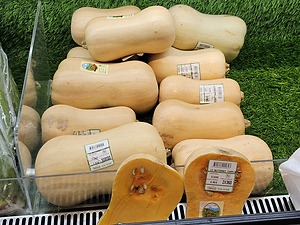


Butternut Squash
Estimated Inventory, 35 lbs : 35.94
This item was last sold on : 07/31/25
Description/Taste
Butternut squash is medium to large in size and has a bell-like shape with a long neck attached to a bulbous end. The smooth skin is very thin, light tan, firm, and is connected to a light brown, rough stem. The long neck of the Butternut squash contains a solid orange, dense, and moist flesh and in the bulbous end, there is a small hollow seed cavity with stringy pulp and a few flat, cream-colored seeds. When cooked, the flesh of the Butternut squash becomes tender and offers a mild squash flavor with sweet and nutty nuances.
Seasons/Availability
Butternut squash is available year-round, with peak season in the fall through winter.
Current Facts
Butternut squash, botanically classified as Cucurbita moschata, is a winter squash that grows on a trailing vine and is a member of the Cucurbitaceae family along with gourds and pumpkins. A relatively new variety, the Butternut squash we know today is the result of years of crookneck squash breeding to produce a variety with a more compact size, straight-necked trait, and stackable capabilities. Butternut squash is one of the most popular modern varieties on the market today and is valued for its thin, edible skin, dense flesh, and small seed cavity that produces little waste in cooking. It is also classified as a fruit but is commonly prepared as a vegetable and can be used in a wide variety of culinary applications.
Nutritional Value
Butternut squash provides vitamins A, C, and E, manganese, potassium, iron, soluble fiber, and magnesium. Deep orange colored squashes such as the Butternut are also rich in beta-carotene.
Applications
Butternut squash is best suited for cooked applications such as roasting, toasting, steaming, sautéing, baking, braising, and grilling. It can be sliced into rounds, wedges, or cubes and added to curries, chili, soups, stews, risotto, a filling for tacos, enchiladas, empanadas, and ravioli. It can also be diced and used in lieu of potatoes in a hash or served atop pizza and flatbread. Butternut squash can be used in baked goods such as pies, bread, and muffins. The seeds of the squash are also popularly roasted, salted, and consumed as a snack food similar to pumpkin seeds. Butternut squash pairs well with sage, thyme, bay leaf, apple, cinnamon, pear, shallots, pecans, butter, cream, feta cheese, ground beef, sausage, and bacon. It will keep 1-2 months when stored in a cool, dark, and dry place.
Ethnic/Cultural Info
Initially, straight neck winter squashes were not a preferred variety, and the lengthy, curvy winter crooknecks were the squash of choice. As the commercial shipping and distribution of squash in bulk increased in demand, the need for winter squash that was stackable and compact grew and inspired the development of modern Butternut varieties. This squash is also known for its thin skin, small seed cavity, and dense flesh which gives it the largest amount of flesh per dollar. The name of the original Butternut squash is believed to have come from the squash creator, Charles A. Leggett, who described the Butternut’s flavor as, “smooth as butter and sweet as a nut.” Today the farmland in Massachusetts where the original Butternut squash was developed is now a golf course aptly named, Butternut Farm Golf Club.
Geography/History
Early Butternut squashes were believed to have originated in the United States in the 1930’s as a natural outcrossing or mutation of the Canadian crookneck squash. These early Butternuts were problematic as the plants were not dependable in providing consistent production of straight necked squashes. As demand for compact, straight-necked squash increased and bulky crooknecks fell out of fashion, plant breeders worked hard to breed out these inconsistencies. One of the earliest known dependable Butternut varieties was believed to have been created by amateur breeder Charles A. Leggett around 1940, and after much experimentation in the garden, Leggett brought his squash to the Waltham Agricultural Experiment field station where the Waltham family helped to popularize his Butternut squash. Credit for the creation of this early Butternut variety is also given to Professor Robert E. Young of the Massachusetts College of Agriculture, who worked with the original squash from Leggett to create what would come to be known as the Waltham Butternut squash. Today Butternut squash is widely available in grocers and farmers markets in North America, Central America, South America, Europe, Asia, South Africa, Australia, and New Zealand.
Featured Restaurants
Restaurants currently purchasing this product as an ingredient for their menu.
| The Plot Restaurant (Costa Mesa) | Costa Mesa CA | 714-852-3181 |
| Toast Catering | San Diego CA | 619-795-9135 |
| Red Door Friends | San Diego CA | 619-295-6000 |
| Ranch Catering | San Diego CA | 858-491-9100 |
| Rancho Valencia | Del Mar CA | 858-756-1123 |
| Joya Kitchen | San Diego CA | 619-255-5979 |
| California Culinary Arts Institute | San Diego CA | 858-868-1401 |
| Bencotto Italian Kitchen | San Diego CA | 619-822-5493 |
| Marriott Coronado | Coronado CA | 619-435-3000 x6335 |
| Civico 1845 | San Diego CA | 574-210-4025 |
| Ron Oliver | San Diego | 619-295-3172 |
| Aztec Shop Catering | San Diego CA | 619 594-3576 |
| Hotel La Jolla - Sea & Sky | La Jolla CA | 858-459-0261 |
| Slowly | San Diego CA | 858-352-6080 |
| Coast Catering | Escondido CA | 619-295-3173 |
| Maderas Golf Club | Poway CA | 858-451-8100 |
| Marriott Del Mar | San Diego CA | 858-369-6029 |
| Reata Glen | Ladera Ranch CA | 949-545-2250 |
| Chocolate Bar | Carlsbad CA | 442-500-2007 |
| Lauberge Del Mar | Del Mar CA | 858-259-1515 |
| Fresco Cocina | Carlsbad CA | 760-720-3737 |
| Mothership | San Diego CA | 858-342-3609 |
| Rancho Santa Fe Golf Club | Rancho Santa Fe CA | 858-756-1582 |
| Farm Fresh Meals | Vista CA | 760-707-2383 |
| Junkyard Sports Bar and Grill | Oceanside CA | 760-407-8500 |
| Portside Pier (Ketch Tasting Deck) | San Diego CA | 858-268-1030 |
| Rosemary Trattoria | Coronado CA | 619-669-8435 |
| Crest Cafe | San Diego CA | 619-295-2510 |
| The Flavor Chef (Catering) | Vista CA | 619-295-3172 |
| Isola La Jolla | La Jolla CA | 858-412-5566 |
| Inn at Rancho Santa Fe (Banquet) | Rancho Santa Fe CA | 858-381-8289 |
| Institutes of Health LLC | San Diego CA | 800-270-5016 |
| Alila Marea Beach Resort | Encinitas CA | 805-539-9719 |
| Gold Finch | San Diego CA | 619-804-2051 |
| Chateau La Jolla | San Diego CA | 858-459-4451 |
| Solare Ristorante Lounge | San Diego CA | 619-270-9670 |
| Madison | San Diego CA | 619-822-3465 |
| Tom Hams Light House | San Diego CA | 619-291-9110 |
| Bleu Boheme | San Diego CA | 619-255-4167 |
| Ridgeview Health Center | San Diego CA | 858-293-3950 |
| Shoreside Support Boat | San Diego CA | 704-277-7929 |
| Ciccia Osteria | San Diego CA | 619-674-4069 |
| Pacific Regent La Jolla | San Diego CA | 858-597-8008 |
| Urban Kitchen Catering | San Diego CA | 619-276-8803 |
| The Privateer Coal Fire Pizza | Oceanside CA | 760-310-1535 |
| UCSD Health East campus | San Diego CA | 619-578-3373 |
| Knotty Barrel- Rancho | San Diego CA | 858-484-8758 |
| Cape Rey Carlsbad, a Hilton Resort | Carlsbad CA | 760-602-0800 |
| Kairoa Brewing Company | San Diego CA | 858-735-0051 |
| My Chef | San Diego CA | 916-217-0049 |
| Sheldons Service Station | La Mesa CA | 619-741-8577 |
| WaterBar | San Diego CA | 619-308-6500 |
| Bernini's Bistro | La Jolla CA | 858-454-5013 |
| Searcher Sportfishing | San Diego CA | 619-861-4640 |
| Ketch Grill and Taps | San Diego CA | 858-268-1030 |
| Jeune Et Jolie | Carlsbad CA | 858-231-0862 |
| Lilo | Carlsbad CA | 619-385-0914 |
| Mission Ave Bar and Grill | Oceanside CA | 760-717-5899 |
| Encontro North Park | San Diego CA | 310-955-6333 |
| Burgo Direct | Chula Vista CA | 619-793-2325 |
| Miho | San Diego CA | 619-365-5655 |
| C 2 C | San Diego CA | 619-972-9345 |
| The Remy | San Diego CA | 619-886-1358 |
| Valley View Casino & Hotel (Black&Blue) | Valley Center CA | 760-291-5500 |
| US Grant Hotel Main | San Diego CA | 619-232-3121 |
| UCSD Food & Nutrition Department Hillcrest | San Diego CA | 619-380-9840 |
Recipe Ideas
Recipes that include Butternut Squash. One



